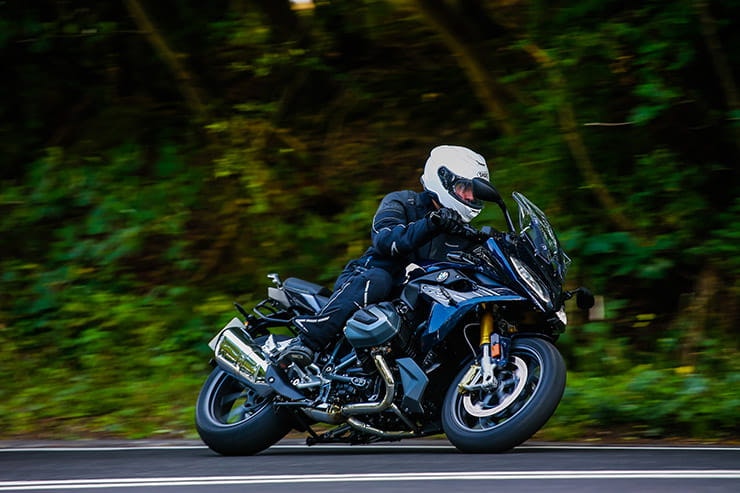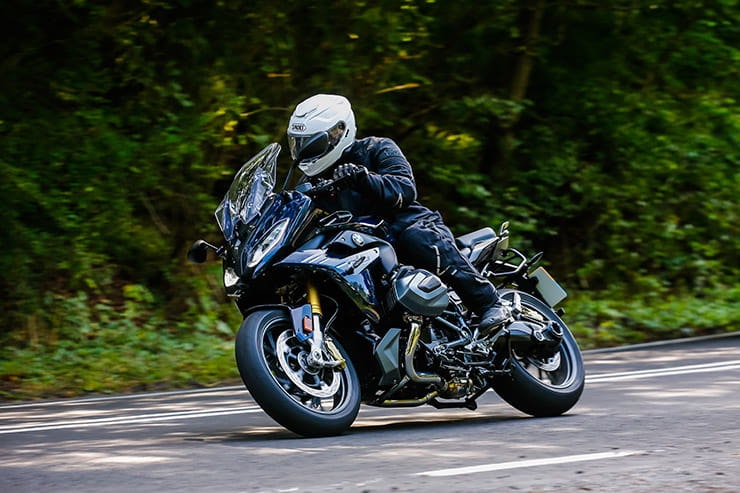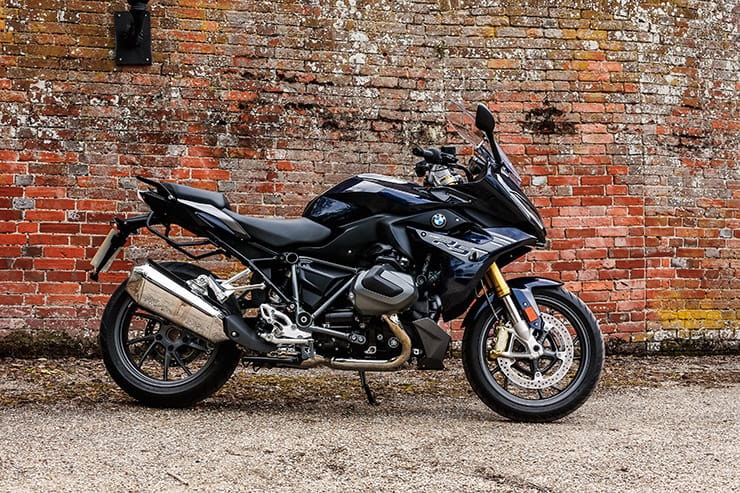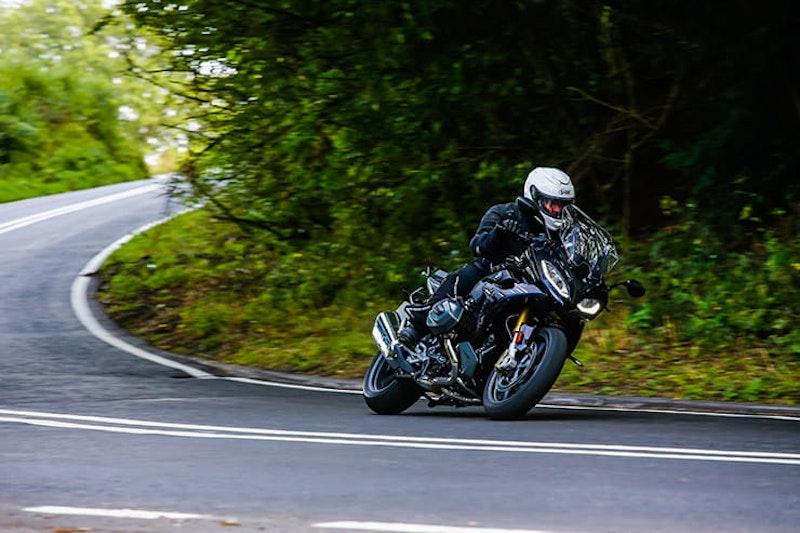BMW R1250RS (2023) - Review
By Steve Rose
BikeSocial Publisher
20.04.2023
First reviewed August 2019
‘Now listen carefully Bond…this new R1250RS has a lot of special features.’ Looking through the press pack on BMW’s new R1250RS it’s all too easy to go gizmo-blind. As well as the multiple riding modes and (optional – but almost everyone chooses them) electronic suspension system’s settings, there’s the traction control, auto hill-start functions, ABS, quickshifter, auto-preload-setting, keyless ignition, multiple display modes on the new TFT screen, fly-by-wire throttle, tyre pressure sensors, LED running lights, Bluetooth connectivity and turn-by-turn navigation directions via the app.
Once you’ve set that lot up all you need to do is push the start button, engage gear and you’re ready to go. All those 1960s outlaw biker movies would have been an hour or so longer if the bad boys had to select the optimal parameters before firing up and charging off into the sunset. ‘Whaccha rebelling against Johnny?’ ‘Well Bubba, I can’t quite decide whether it’s damp enough for rain mode and whether I need Dynamic or Dynamic-pro. Shall we just dance instead?’
The truth is that for all the new tech (much of it was previously optional but now fitted as standard), the two things you need to know about BMW’s R1250RS are that the superb ShiftCam engine is probably even more suited to this bike than the naked R1200R or GS and that the TFT display fixes the biggest single problem of the old R1200RS – that the typical middle-aged RS customer’s eyes were no longer able to read any of the digits on the teeny, tiny LCD display.
Revised styling, new engine, more gadgets, pretty-much the same price as before.
2019 BMW R1250RS price
The standard bike starts at £12,100 which comes with the new TFT display, traction control, two riding modes (road and rain), cornering-ABS, conventional (non-electronic) suspension, pannier mounts and a traditional key for the ignition and fuel filler and hill-start assist.
The Sport model costs £13,465 and adds a quickshifter, more sophisticated DTC-pro traction control, heated grips, belly pan, chrome exhaust and tyre-pressure sensors.
The top-spec Exclusive model costs £13,960 and offers different kinds of equipment to the Sport. This one has electronic suspension adjustment, keyless ignition, a centre stand, GPS preparation and cruise control (but no heated grips, which seems weird for a bike obviously aimed at touring).
To put that in perspective, the standard RS is a few hundred quid cheaper than Honda’s CB1000R and a full £5k less than the KTM Super Duke GT I rode down to the launch on. You can (and should) argue that the KTM makes much more power and has many of the BMW’s optional gadgets as standard, but I’d argue that the BMW’s engine is (much) better regardless of power figures and I’d rather have the conventional suspension, shaft drive and a physical key plus £4k in my pocket, if only the good bits of the KTM weren’t so flipping good (more of that later).
ShiftCam is variable valve timing that works brilliantly and is completely unobtrusive.
2019 BMW R1250RS engine, power and torque
The twin-cylinder, water-cooled ShiftCam boxer engine is the same as in the R1200R, GS and RT models. One of the BMW tech team, on hand to answer questions explained that they had initially considered different levels of tune, but were happy with the versatile performance of the motor and the only differences between models are in the choice of final-drive gear ratios. The R and GS models have the shortest gearing, the RS has slightly longer ratios for more relaxed high-speed cruising and the RT has the longest for relaxed touring.
The new bits for 2019 are the variable valve timing (ShiftCam) and an additional 74cc. Between them, they add a significant 11bhp and 14lb-ft of torque to the Top Trumps numbers but more importantly, power and torque is improved right across the rev range.
The cleverest part of the ShiftCam system (which alters the valve timing by using two sets of lobes on the intake cam, but also allows the valves to open autonomously on each cylinder which also increases gasflow) is that it is undetectable in use. Unlike Honda’s VTEC or Suzuki’s GSX-R1000 system, where there is a noticeable physical feeling in operation, the BMW system is seamless. And unlike Ducati’s system, it really does make a big twin as punchy as you hoped at low revs and as fast when chasing the redline too. ShiftCam sets a new benchmark in motorcycle VVT systems – it’ll be interesting to see how the competition evolves.
Lots of gizmos to control, but the layout makes it simple.
2019 BMW R1250RS quickshifter and electronics
BMW call their quickshifter gear-assist pro. Under certain conditions – big throttle openings in the lower gears, driving hard – it works well enough. But when you’re chugging along in touring mode it’s not consistent, missing or messing-up one in every 20 upshifts and that’s not good enough. It’s better when downshifting, but still no smoother than just using the light clutch.
BMW’s electronic systems make an interesting comparison to the competition. The throttle and quickshifter feel slightly numb (as does the clutch action) as if there’s too much electronic manipulation going on. Compared to a KTM which feels like its systems have been developed by a fanatical engineer whose home will be full of marble surfaces, sharp edges and brushed aluminium toilet paper, the BMW has more of a soft-furnishings, pastel colours and maybe even a bean bag kind-of feel. Does that make any sense? Ducati’s lie somewhere, confused between the two. The BMW systems all work well but lack the directness and aggression of the KTM system.
One area where the BMW scores highly is ease of adjustment. There are more buttons to push on the R1250’s switchgear than the competition (and the ‘what-does-it-do-again?’ wheel still means a long stretch for your thumb to the indicator switch), but the upside is that swapping suspension settings is now just two pushes of a button, the heated grips are one-push and scrolling the menus on the dash is a simple pleasure, even at high speed on a twisty road.
Riding position hasn’t changed from the previous model. Feels radically sporty next to a KTM Super Duke GT.
2019 BMW R1250RS comfort and ergonomics
The riding position and basic shape of the fairing remains the same as on the old R1200RS. The fairing is slightly different to accommodate the new LED lighting and give the 2019 bike a distinctive ‘face’. It’s been a couple of years since I rode an RS and, after 2500 miles on KTM’s Super Duke GT (which, I know is a very different bike in some respects, but it is also a machine designed to be an all-round sporty, touring champion) I was surprised how hard it was to get comfy on the BMW. The riding position is more traditionally sporty. There’s a stretch across the tank to the narrow, forward-set handlebars. At high speeds it feels very natural and it makes cornering more confident because your body feels in just the right place to attack a turn. The KTM is more about attitude and muscling the bike through a turn. It’s as subtle as a skinhead with a bright orange suntan.
But, when you slow down a bit, or are filtering through traffic or just at the end of a long day, on the motorway wanting to get home, the KTM is way more comfortable. The bars feel in just the right place, the seat supports your aching backside and just cants you forward enough to make the reach to the bars easy. On the BMW the seat is softer, but less supportive, the bars are an inch too far away and your feet are too high.
I don’t remember comfort being an issue when I ran an R1200RS for a year in 2017, but I was doing more long, fast runs and less slow riding than on the R1250 launch yesterday. Other than that, the BMW’s ergonomics are good and bad. The clutch feels over-assisted, gear shift has too much squidge and the indicator switch is an inch too far from your thumb, but the sidestand is in the right place for an easy foot, isn’t too long like the KTM and the keyless ignition, steering lock and fuel filler work perfectly every time.
RS model retains the Brembo brakes of the previous model. Cornering ABS is standard
2019 BMW R1250RS suspension, brakes and handling
I love the way this bike handles. The riding position lets you attack a corner without being uncomfortable and the combination of steering geometry, power delivery and suspension behaviour brings a feeling that you are driving hard through every turn with confidence and ability to spare. It’s a while since I rode anything that makes cornering feel this easy and the rider feel like an absolute hero. There’s something very special about this chassis/engine combination.
We only tested bikes with BMW’s electronic suspension adjustment (ESA). This year’s system has an ‘auto-load’ adjustment, which means it sets the preload automatically depending on whether it’s one person, two people, luggage or no luggage and keeps the bike on an even keel. You can switch to manual, but the only options are fully loaded or minimum.
The ESA damping is getting better with each iteration, but there’s a lot of competition in the market now and, depending on how you ride, some are much better systems. BMW’s ESA now has just two settings – road and dynamic. The settings have been tweaked this year to better reflect the riding styles of the actual customers who buy an RS. BMW acknowledge that their mega-experienced test riders and the journalists who review their bikes often have a sportier, harder-riding focus and so have developed the settings more for typical road riders. I tended to leave it in ‘Dynamic’, which is the sportier of the two. This setting allows sporty, precise cornering while also soaking up most of the bumps on most of the roads well. It only got caught out on a couple of very big bumps on a very minor single-track road. In ‘Road’ mode, it felt slightly more comfortable, but was noticeably less accurate in the kind of corners where you misjudge the line and need to adjust mid-corner.
BMW have retained the Brembo brakes on the RS (the GS and RT versions have BMW-branded calipers made by American company Hayes). On our ride they work as well as ever, but we didn’t really put them to the test. BMW’s tech guy discussed how the electronics develop all the time and how the algorithms driving the latest cornering ABS system allows it to react faster and more smoothly.
Hill start control is also fitted as standard now and worked well on the single occasion I had to test it. Previous experience suggests that, while no one will buy an R1250RS purely for this gizmo, once you get used to it the system becomes much more useful than you imagined it would be.
TFT display is easy to read, easy to use and can become a sat-nav when used with your phone and the BMW app.
2019 BMW R1250RS instruments
When I ran the old model as a long term test bike in 2017 my biggest bugbear was the instrument panel, which had tiny numbers that were impossible to see clearly on the move. The new TFT unit is huge, brash, bright and laid out in such a way that all the info is right where you need it and the menus make it simple to access everything you need. BMW’s switchgear is more cluttered than some, with more buttons and wheels to manipulate than KTM, for example, but the result is a series of controls that are easier to use on the move.
Simple screen adjustment and more powerful LED headlights.
2019 BMW R1250RS verdict
You can’t judge a bike like this on the basis of a launch ride. It’s a multi-purpose bike and needs a few thousand miles to really get to know it. But you can get an impression of what’s changed from the old one and, having done many thousand of miles on those it’s apparent that the new R1250RS fixes the one big problem with the bike (the hard-to-read clocks) and adds in the bonus of a massively improved engine that just makes you grin like a teenager on a moped every time you open the throttle in anger.
All the other new stuff is detail. Electronics get better every year and we expect them to do more things with fewer glitches. The new suspension settings are a little better, but the old ones weren’t a significant problem and the LED lights are pretty, but not essential.
The biggest challenge for the new RS is the fact that the sports touring market has changed so much. Kawasaki’s H2 SX beats everything on performance and is a good all-round package, Honda has effectively given up on sports touring, we’re still waiting for Yamaha’s MT-10-based Tracer and Ducati’s Supersport isn’t really comfy enough.
KTM’s Super Duke GT has moved the sporty touring market down a whole new path and is genuinely good at everything. But it costs £17,000, which is £3k more than a top-spec R1250RS and, despite what the spec sheet says I reckon it’s no faster on the open road.
I really enjoyed the R1250RS but I want to do a lot more miles on a standard version because at £12,100 it’s probably the one I’d buy.
Second (and third) opinion: John Milbank, April 2023
As the owner of a 2019 BMW R1250GS, I’ve often wondered if I should have opted for the more compact and manageable RS. As Steve’s already done a great job of covering the sportier, sleeker bike above, I’ll jump straight in after putting several hundred miles on this machine…
No, I shouldn’t have bought this one.
But, and it’s a big but, that’s simply because of the roads I ride and the comfort I’m looking for.
While it has the same torquey shift-cam engine (more torque than a Panigale V4R), the final drive gearing changes might make for a faster motorcycle, but on the twisty, bumpy back roads I explore, there’s no advantage.
In fact, I’d argue that I can ride the GS faster than this thanks to the outstanding Telelever suspension that the RS shuns in favour of (still great) semi-active traditional forks in this every-extra-possible top-spec model. The wonderfully unobtrusive but controlled electronic suspension of the RS handled everything the rough Fenland roads threw at it, but when things got really choppy, the GS felt a little more in control.
Maybe the weight helps, but surprisingly the RS is only 6kg lighter. And about 2kg of that will be down to the 2 litre-smaller tank. I have the GS, rather than GS Adventure, so dropping down to an 18 litre tank wasn’t too much of a shock. I saw my typical economy of about 42mpg being the same on both bikes, giving a range to empty of 185 miles on the GS, compared to 167 miles on the RS. I tend to be pretty heavy-handed on the throttle, so checking owner reports at Fuelly.com, the average for the GS was 45.4mpg, while the RS was 49.4mpg. Which means about 196 miles to empty on the RS and 200 miles on the GS. Long story short, there’s nothing in it really.
Despite also owning a 1999 Kawasaki ZX-6R, I do prefer the more upright riding position of the GS over the RS. They’re both very comfortable, but the adventure bike has the edge for me. And the standard screen buffets me less. And it’s just that little bit more roomy when my wife’s with me.
Both BMWs have outstanding load capacity, easily taking panniers and a top box, with the semi-active suspension saving your knuckles from having to adjust the preload. The maximum payload of the GS is 216kg, while the RS is 217kg. Nothing in it again, though I do wish my GS had the handy under-seat storage of the RS.
I bought my GS second-hand, but if I were buying either bike new right now, with the accessories I’d want the GS would cost £19,440, and the RS would be £16,830. Current used prices see a three-year-old GS at £12-£16K, while the RS is about £10-£12K. As resale values of BMW motorcycles tend to be very good, the choice will come down to how deep your pockets are and which features you want most.
Personally, I’ll be sticking with the GS. Though I wish it had that cool sports-style dash of the RS…
There will be many that’ll choose the RS over the GS, but I loaned Simon Roberts, owner of an R1200GSA – the R1250RS for a few days, and after putting a good few hundred miles on too, this is what he thought of the sportier tourer…
“This bike is quality everywhere,” he told me. “There’s some very clever tech compared to my older GSA, it’s agile, it’s refined and the shift-cam tech is genius.
“I think the term ‘soft sports’ is perfect for the RS thanks to the ergonomics, and while I’d say this is more sporty that touring, I personally would like it to be a bit sportier still, to more clearly differentiate it from the R1250RT. The RT would, for me at least, offer the full touring package without going down the adventure bike route or getting a K1600.
“A great dash, great brakes, great shaft drive and no vibes … it’s great at everything, but I didn’t find it amazing at everything. I’ll be sticking with my GSA for a bit longer yet.”
R1250RS vs R1250GS
Which is the best on road?
Three things we loved about the 2019 BMW R1250RS
The engine and power delivery
The price
The chassis
Three things we’re not so sure about
The low speed comfort
The quickshifter (on upshifts)
The slightly-too-long-reach to the indicator switch (which sounds very minor, but really hacks you off after a while)
2019 BMW R 1250 RS - Technical Specifications
Looking for motorcycle insurance? Get a quote for this motorbike with Bennetts bike insurance



